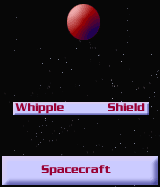 |
 |
 |
Protecting your Spacecraft
How will you protect your spacecraft from debris too small to collect? There are three main ways to protect your spacecraft: passive, active, and operational.
 Passive protection consists of shielding—such as Whipple Shields—to protect the spacecraft from impacts. An aluminum bumper melts or vaporizes high-velocity objects on impact. It also slows any remaining fragments and spreads them out before they hit the spacecraft itself. |
|
|
|
Other spacecraft are designed so their instrumentation face backwards—the Space Shuttle usually flies tail or bottom first to protect its windows and cargo bay from orbital debris. |
Think about how you will protect your spacecraft! Then explore another briefing topic, or begin designing your spacecraft!
|
Spacecraft images copyright 1996-97, California Institute of Technology.
All rights reserved. Further reproduction prohibited. Shuttle and earth image courtesy NASA |
 Active
protection uses sensors to warn of impact. Currently, the only such
sensors are ground-based stations, but onboard sensors have been proposed.
The spacecraft might then protect itself by closing shutters over sensitive
equipment or rotate itself so sensitive components are not exposed to
the oncoming object. More daring proposals suggest shooting the oncoming
objects with laser or plasma beams.
Active
protection uses sensors to warn of impact. Currently, the only such
sensors are ground-based stations, but onboard sensors have been proposed.
The spacecraft might then protect itself by closing shutters over sensitive
equipment or rotate itself so sensitive components are not exposed to
the oncoming object. More daring proposals suggest shooting the oncoming
objects with laser or plasma beams. Operational
protection changes a spacecraft's design or operations so it can
survive impacts. For example, there is less debris at lower orbits,
so a craft orbiting the Earth in a low orbit (below 320 km) is safer
from impact.
Operational
protection changes a spacecraft's design or operations so it can
survive impacts. For example, there is less debris at lower orbits,
so a craft orbiting the Earth in a low orbit (below 320 km) is safer
from impact.